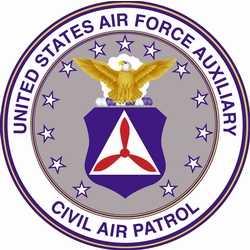Fri, Aug 27, 2010
And The Fiscal Year Has A Month Yet To Go
 The Civil Air Patrol reached a major milestone earlier this
summer, racking up its 100th save for fiscal 2010 … a year
that doesn't end until September 30.
The Civil Air Patrol reached a major milestone earlier this
summer, racking up its 100th save for fiscal 2010 … a year
that doesn't end until September 30.
"There is no better reward than the realization that your efforts
actually made the difference," said Col. Michael J. Murrell, CAP's
senior adviser, operations. "It is that reward for which we all
strive and we succeeded more than 100 times this year. That is an
outstanding milestone!"
CAP reached the century mark in saved lives when a Wyoming Wing
aircrew found an elderly couple whose vehicle was stuck in the mud
in rural Natrona County. The aircrew, acting on information from
the sheriff's office and a hunch from Maj. George Twitchell, the
wing's director of operations, found the couple safe and sound.
"They were in good shape when we found them, but very grateful and
very glad to see us," said Twitchell. "It turned out to be a very
lucky find. It would have been hard for the sheriff's ground search
teams to find them because where they were stuck was kind of tucked
away."
While this particular mission's success stemmed at least in part
from Twitchell's intuition, enhanced use of new technologies is
playing a large role in many CAP search and rescue missions and has
contributed to the high number of saves this year, said John
Desmarais, interim missions director at CAP National Headquarters
at Maxwell AFB. "Some changes in how we do business are resulting
in many of these searches becoming saves," Desmarais said. "We now
have a couple of teams working on utilizing data forensics, both
cell phone and radar forensics."
Both techniques help narrow search areas by analyzing data. Several
CAP members, including the Arizona Wing's Capt. Justin Ogden, who
works with cell phone forensics, are developing these tools and
training other members to use them. Ogden was recently selected to
receive the 2010 Distinguished Volunteer Public Benefit Flying
Award from the National Aeronautic Association and the Air Care
Alliance. "By tightening the search area, they shorten searches for
us," Desmarais said. "The quicker we get there, the more likely it
is that there will be survivors. Both radar and cell phone
forensics can make a significant difference in a search and rescue
mission."
The numbers tell the story. Both technologies have been in use for
a few years, increasing each year. In 2009, CAP had 72 saves. And
while the number has hit 100 before, the yearly average over the
last four decades stands at 84. "I am delighted and very proud of
our aircrews and ground teams for the dedication they have to their
missions," added Murrell. "They train long and hard so that they
will be ready when the call comes, whether it is in the middle of
the day or the middle of the night. They understand any call, at
any time, can mean the difference between life and death."
Increased CAP responsibilities have led to more saves, too. "We are
working more," Desmarais said. "Many saves this year have come on
just a few missions, those we conducted after natural disasters
like floods."
But no matter how CAP got to the 100 mark, it's important not to
get lost in the statistics. Every individual life saved matters. "A
save, every save, is the ultimate outcome," said Wyoming Wing
Commander Col. Stan Skrabut. "We spend a lot of time training our
crews to do this, so the fact that we bring comfort to folks by
finding them safe is the best reward for the time and effort we put
in."
More News
Also: New Lakeland Fly-in!, Gleim's DPE, MOSAIC! Nearly three-quarters of a century in the making, EAA is excited about the future… especially with the potential of a MOSAIC>[...]
Estimated (EST) -When used in NOTAMs “EST” is a contraction that is used by the issuing authority only when the condition is expected to return to service prior to the >[...]
Aero Linx: Regional Airline Association (RAA) Regional airlines provide critical links connecting communities throughout North America to the national and international air transpo>[...]
The Airplane Broke Up In Flight And Descended To The Ground. The Debris Path Extended For About 1,435 Ft. Analysis: The pilot, who was the owner and builder of the experimental, am>[...]
From 2015 (YouTube version): History Comes Alive Thanks to A Magnificent CAF Effort The story of the Douglas C-47 named, “That’s all Brother,” is fascinating from>[...]
 Airborne 07.21.25: Nighthawk!, Hartzell Expands, Deltahawk 350HP!
Airborne 07.21.25: Nighthawk!, Hartzell Expands, Deltahawk 350HP! ANN's Daily Aero-Term (07.27.25): Estimated (EST)
ANN's Daily Aero-Term (07.27.25): Estimated (EST) ANN's Daily Aero-Linx (07.27.25)
ANN's Daily Aero-Linx (07.27.25) NTSB Final Report: Luce Buttercup
NTSB Final Report: Luce Buttercup Classic Aero-TV: 'That's All Brother'-Restoring a True Piece of Military History
Classic Aero-TV: 'That's All Brother'-Restoring a True Piece of Military History



